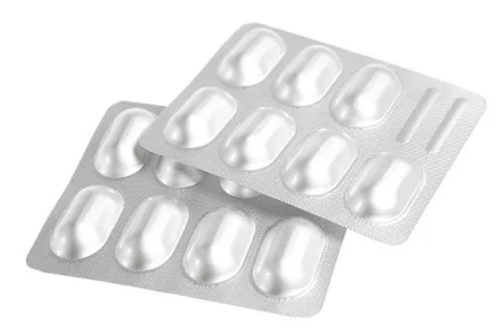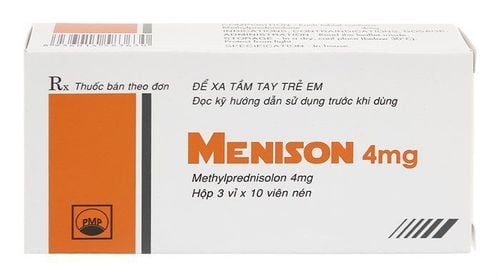This is an automatically translated article.
Camrox belongs to the group of non-steroidal anti-inflammatory drugs (NSAIDs), commonly indicated for use in the treatment of pain and inflammation in rheumatic diseases and osteoarthritis. In addition to the effective effects of the drug, patients should also be careful with unwanted side effects.1. What are the effects of Camrox?
Camrox's main ingredient is Meloxicam, which belongs to the group of analgesics, antipyretics, non-steroid anti-inflammatory drugs, drugs for the treatment of Gout and osteoarthritis. Doctors often prescribe Camrox to treat diseases:Symptoms of osteoarthritis, rheumatoid arthritis, rheumatoid arthritis and other inflammatory and painful conditions. The main ingredient Meloxicam is also effective in analgesic, antipyretic, anti-inflammatory and anti-platelet aggregation. Camrox is indicated for the treatment of juvenile rheumatoid arthritis (JRA) in patients 2 years of age and older. Mechanism of action:
Ingredients Meloxicam belongs to the group of non-steroidal anti-inflammatory drugs (NSAIDs) of the Oxicam family, with analgesic, anti-inflammatory and antipyretic effects. Meloxicam has strong anti-inflammatory properties for all types of inflammation. Meloxicam has the ability to inhibit the biosynthesis of prostaglandins, mediators of inflammation.
2. Dosage and usage
How to use: Camrox drug is prepared in the form of tablets should be compressed and used orally.Dosage:
In the treatment of rheumatoid arthritis and ankylosing spondylitis, the dosage is 15mg/day. When the body can respond to the drug, the patient can reduce the dose to 7.5mg / day. In the treatment of osteoarthritis, the dose is 7.5mg/day, which can be increased to 15mg/day when necessary. However, the maximum dose should be used only 15mg/day. Contraindications:
Do not use Camrox for patients with hypersensitivity to Meloxicam or any of its ingredients. Do not use in patients with a history of asthma, angioedema, urticaria caused by taking aspirin. Camrox should not be used in patients with a history of or ongoing peptic ulcer disease. Camrox should not be used in patients with severe liver or kidney failure. Camrox is contraindicated in children under 15 years of age.
3. Side effects
Side effects that may occur when patients use Camrox include:Cardiovascular effects: Chest pain or discomfort, shortness of breath, cold sweats, pain or discomfort in one or both arms, back, shoulder, neck, jaw or area above the navel Side effects affecting the stomach and intestines: These include symptoms such as bleeding, stomach ulcer or tear, severe stomach pain, vomiting blood, passing stools bloody stools, black stools. Liver damage: Symptoms may include dark urine or pale stools, nausea, not wanting to eat, pain in your stomach area, yellowing of your skin or the whites of your eyes Symptoms of extremely high blood pressure may include: Nosebleeds, dizziness, headache. Skin reactions : Common skin problems such as blistering, peeling or red rash on the skin. Other serious side effects that can be experienced while taking Camrox include heart disease, stroke, kidney problems, and stomach ulcers. Using meloxicam can cause gastrointestinal toxicity and bleeding, headache, rash, and very dark or black stools (signs of intestinal bleeding). Like other NSAIDs, its use is associated with an increased risk of cardiovascular events such as heart attack and stroke.
4. Be careful when using Camrox
People with high blood pressure, high cholesterol, or diabetes are at increased risk for cardiovascular side effects. People with a family history of heart disease, heart attack, or stroke should tell their doctor because the potential for serious cardiovascular side effects is great. NSAIDs increase the risk of serious side effects affecting the gastrointestinal tract including bleeding, ulceration, and perforation of the stomach or intestines, which can be fatal. Elderly patients are more likely to experience gastrointestinal problems. Meloxicam is recommended to be discontinued for at least four to six months prior to surgical or dental procedures due to the increased risk of side effects such as mouth ulcers and dry mouth. Doctors recommend not taking Camrox with pregnant women, especially women in the last three months of pregnancy.
5. Drug interactions
Drug interaction is the phenomenon of changing the effect of a drug or increasing the unwanted side effects of the drug, when used simultaneously with other drugs, food,... Therefore to avoid this situation from happening. In addition, patients should inform their doctor or pharmacist of any drugs they are taking or have recently taken before taking this medicine. The following are drugs that should not be used in combination with Camrox:Taking meloxicam in combination with some antidepressants and anxiety medicines causes side effects that increase the risk of bleeding. Taking cyclosporine with meloxicam can increase the level of cyclosporine in your body causing kidney problems. If the patient is taking these drugs together, renal function should be monitored regularly. Taking methotrexate with meloxicam might increase the levels of methotrexate in the body. Interactions between these two drugs can increase the risk of nephrotoxicity and infection. Taking warfarin with meloxicam increases the risk of stomach bleeding. Taking meloxicam with corticosteroids such as prednisone, dexamethasone,... may increase the risk of stomach ulcers or bleeding. Taking pemetrexed with meloxicam may increase your risk of infection, kidney and stomach problems. Abacavir: Meloxicam may decrease the rate of excretion of Abacavir, which may lead to higher serum concentrations. Abametapir: The serum concentration of Meloxicam may be increased when it is combined with Abametapir. Abatacept: The metabolism of Meloxicam may be increased when combined with Abatacept. Abciximab: The risk or severity of bleeding and bleeding may be increased when Meloxicam is combined with Abciximab Abrocitinib: The metabolism of Abrocitinib may be decreased when combined with Meloxicam. Acebutolol: Meloxicam may decrease the blood pressure lowering activities of Acebutolol. Acemetacin: The risk or severity of side effects may be increased when Meloxicam is combined with Acemetacin. Acenocoumarol: The risk or severity of bleeding may be increased when Meloxicam is combined with Acenocoumarol. Acetazolamide: The therapeutic efficacy of Acetazolamide may be reduced when used in combination with Meloxicam. Acetohexamide: The protein binding of Acetohexamide may be reduced when combined with Meloxicam. Acetylsalicylic acid: The risk or severity of gastrointestinal bleeding may be increased when Meloxicam is combined with Acetylsalicylic acid. Acyclovir: The risk or severity of nephrotoxicity may be increased when Acyclovir is combined with Meloxicam.













